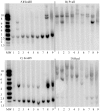Neoplastic transformation of T lymphocytes through transgenic expression of a virus host modification protein
- PMID: 22558084
- PMCID: PMC3338727
- DOI: 10.1371/journal.pone.0034140
Neoplastic transformation of T lymphocytes through transgenic expression of a virus host modification protein
Abstract
Virus host evasion genes are ready-made tools for gene manipulation and therapy. In this work we have assessed the impact in vivo of the evasion gene A238L of the African Swine Fever Virus, a gene which inhibits transcription mediated by both NF-κB and NFAT. The A238L gene has been selectively expressed in mouse T lymphocytes using tissue specific promoter, enhancer and locus control region sequences for CD2. The resulting two independently derived transgenic mice expressed the transgene and developed a metastasic, angiogenic and transplantable CD4(+)CD8(+)CD69(-) lymphoma. The CD4(+)CD8(+)CD69(-) cells also grew vigorously in vitro. The absence of CD69 from the tumour cells suggests that they were derived from T cells at a stage prior to positive selection. In contrast, transgenic mice similarly expressing a mutant A238L, solely inhibiting transcription mediated by NF-κB, were indistinguishable from wild type mice. Expression of Rag1, Rag2, TCRβ-V8.2, CD25, FoxP3, Bcl3, Bcl2 l14, Myc, IL-2, NFAT1 and Itk, by purified CD4(+)CD8(+)CD69(-) thymocytes from A238L transgenic mice was consistent with the phenotype. Similarly evaluated expression profiles of CD4(+)CD8(+) CD69(-) thymocytes from the mutant A238L transgenic mice were comparable to those of wild type mice. These features, together with the demonstration of (mono-)oligoclonality, suggest a transgene-NFAT-dependent transformation yielding a lymphoma with a phenotype reminiscent of some acute lymphoblastic lymphomas.
Conflict of interest statement
Figures







Similar articles
-
Identification and utility of innate immune system evasion mechanisms of ASFV.Virus Res. 2013 Apr;173(1):87-100. doi: 10.1016/j.virusres.2012.10.013. Epub 2012 Nov 16. Virus Res. 2013. PMID: 23165138 Review.
-
Cooperation of Gata3, c-Myc and Notch in malignant transformation of double positive thymocytes.Mol Immunol. 2008 Jun;45(11):3085-95. doi: 10.1016/j.molimm.2008.03.018. Epub 2008 May 8. Mol Immunol. 2008. PMID: 18471881
-
Impact on antibody responses of B-cell-restricted transgenic expression of a viral gene inhibiting activation of NF-κB and NFAT.Arch Virol. 2015 Jun;160(6):1477-88. doi: 10.1007/s00705-015-2419-x. Epub 2015 Apr 12. Arch Virol. 2015. PMID: 25864175
-
The viral protein A238L inhibits cyclooxygenase-2 expression through a nuclear factor of activated T cell-dependent transactivation pathway.J Biol Chem. 2004 Dec 17;279(51):53736-46. doi: 10.1074/jbc.M406620200. Epub 2004 Oct 7. J Biol Chem. 2004. PMID: 15471864
-
The regulation and function of the CD4 coreceptor during T lymphocyte development.Curr Top Microbiol Immunol. 1996;205:89-106. doi: 10.1007/978-3-642-79798-9_5. Curr Top Microbiol Immunol. 1996. PMID: 8575199 Review.
Cited by
-
African Swine Fever Virus F317L Protein Inhibits NF-κB Activation To Evade Host Immune Response and Promote Viral Replication.mSphere. 2021 Oct 27;6(5):e0065821. doi: 10.1128/mSphere.00658-21. Epub 2021 Oct 20. mSphere. 2021. PMID: 34668754 Free PMC article.
References
-
- Finlay BB, McFadden G. 2006. (2006) Anti-immunology: evasion of the host immune system by bacterial and viral pathogens. Cell 124: 767–782. Available: http://www.ncbi.nlm.nih.gov/pubmed/16497587.
-
- Vischer HF, Vink C, Smit MJ. 2006. (2006) A viral conspiracy: hijacking the chemokine system through virally encoded pirated chemokine receptors. Current topics in microbiology and immunology 303: 121–154. Available: http://www.ncbi.nlm.nih.gov/pubmed/16570859. - PubMed
-
- Loo YM, Gale M. 2007. (2007) Viral regulation and evasion of the host response. Current topics in microbiology and immunology 316: 295–313. Available: http://www.ncbi.nlm.nih.gov/pubmed/17969453.
-
- Unterholzner L, Bowie AG. 2008. (2008) The interplay between viruses and innate immune signaling: recent insights and therapeutic opportunities. Biochemical pharmacology 75: 589–602. Available: http://www.ncbi.nlm.nih.gov/pubmed/17868652. - PubMed
-
- Bonjardim CA, Ferreira PCP, Kroon EG. 2009. (2009) Interferons: signaling, antiviral and viral evasion. Immunology letters 122: 1–11. Available: http://www.ncbi.nlm.nih.gov/pubmed/19059436.
Publication types
MeSH terms
Substances
Grants and funding
LinkOut - more resources
Full Text Sources
Medical
Molecular Biology Databases
Research Materials

